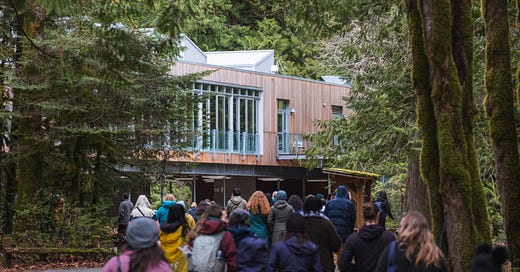It’s the end of March and I’m standing inside of a cedar tree in Squamish, British Columbia. My friends and I are trying to see how many of us can fit inside the trunk, which had been struck by lightning decades earlier, and I’m smushed into the tree’s side while everyone piles in. We’re laughing uncontrollably, and in such close proximity it’s hard to tell that most of us only met 48 hours earlier.
We’re here for the first-ever Youth Environmental Changemakers Summit, organised by The Starfish Canada, to be in relationship as 75 young environmental leaders from across what is currently known as Canada. We’re 15-35 years old, and are spending five days together sharing stories, joy, and solutions. These quick friendships, the kind that have you sandwiched inside of a tree (with at least 7 others!), are my favourite part of the climate community. It’s easy to become friends when you’ve dedicated your lives to creating a better world.
I’ve been asked by friends and colleagues to describe the Summit, and the best answer I can come up with is part-conference-part-camp, which, if I’m being honest, is a model that needs to be followed more. I knew it wouldn’t be the typical stuffy conference experience with fluorescent light, ironed shirts, and “networking nights” (thank goodness), but other than that I hadn’t known what to expect.
And not to be dramatic, but it ended up being some of the most life-affirming days that I’ve had in my short time on this planet.
The Summit was opened on the afternoon of March 28 by Squamish elder Tsawaysia Spukwus (Alice Guss), and she opened with stories of the canoe journeys she’d taken where there’s no choice but to “pull together” to reach your destination.
This generous opening by Tsawaysia, built around themes of collective action and solidarity, opened our gathering in a good way and was woven throughout the rest of the Summit.
We spent the rest of the summit orbiting discussion circles, workshops on rest and non-violent communication, and embracing “unsanctioned” dance parties and river swims during our free time.
It would have been easy for all of us to treat the summit as a fleeting moment, enjoying each other’s company and the workshops but never going deeper. Instead, in one of those rare instances, we’ve continued to be in relationship and align our work. People have created virtual reading groups, shown up to each other’s events, started new projects together, and slept over in each other’s living rooms.
I’ve had several months to reflect on my time since the Starfish Summit, and on why it was such a generative environment for my friends and I.
I’ve been out of university and working in the “professional” world for almost a year, and I feel that my climate activism, at some point unknown, became diluted by my distance from student organising. I’ve been too passive to speak out on things that matter out of fear of seeming “too political,” and I’ve lowered my expectations to what people tell me is possible. The transition from imaginative and horizontal student communities into a staunchly hierarchical workforce shocked my system and dampened my creativity.
More concerningly, I’d started to think that building a flourishing world was radical.
Being surrounded by youth, all from vastly different geographies, intersections, lived experiences, and interests brought me back to where I knew I needed to be. Working in community, building reciprocal projects, and remembering that collaboration, not competition, are what will get us to a livable future. Yes, all of these things may seem like “well, duh…” but it’s freakishly easy to get co-opted into palatable, “practical” work when you’re separated from your community. Here’s to finding the people who make your heart full and your mind expansive.
Here’s to the world we dream about.
Discussion about this post
No posts





